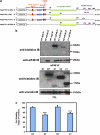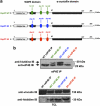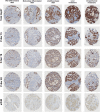OGX-427 inhibits tumor progression and enhances gemcitabine chemotherapy in pancreatic cancer
- PMID: 22012255
- PMCID: PMC3219088
- DOI: 10.1038/cddis.2011.104
OGX-427 inhibits tumor progression and enhances gemcitabine chemotherapy in pancreatic cancer
Abstract
Despite many advances in oncology, almost all patients with pancreatic cancer (PC) die of the disease. Molecularly targeted agents are offering hope for their potential role in helping translate the improved activity of combination chemotherapy into improved survival. Heat shock protein 27 (Hsp27) is a chaperone implicated in several pathological processes such as cancer. Further, Hsp27 expression becomes highly upregulated in cancer cells after chemotherapy. Recently, a modified antisense oligonucleotide that is complementary to Hsp27 (OGX-427) has been developed, which inhibits Hsp27 expression and enhances drug efficacy in cancer xenograft models. Phase II clinical trials using OGX-427 in different cancers like breast, ovarian, bladder, prostate and lung are in progress in the United States and Canada. In this study, we demonstrate using TMA of 181 patients that Hsp27 expression and phosphorylation levels increase in moderately differentiated tumors to become uniformly highly expressed in metastatic samples. Using MiaPaCa-2 cells grown both in vitro and xenografted in mice, we demonstrate that OGX-427 inhibits proliferation, induces apoptosis and also enhances gemcitabine chemosensitivity via a mechanism involving the eukaryotic translation initiation factor 4E. Collectively, these findings suggest that the combination of Hsp27 knockdown with OGX-427 and chemotherapeutic agents such as gemcitabine can be a novel strategy to inhibit the progression of pancreas cancer.
Figures







References
-
- Van Laethem JL, Verslype C, Iovanna JL, Michl P, Conroy T, Louvet C, et al. New strategies and designs in pancreatic cancer research: consensus guidelines report from a European expert panel Ann Oncol 2011. e-pub ahead of print 1 August 2011. - PubMed
-
- Conroy T, Desseigne F, Ychou M, Bouche O, Guimbaud R, Becouarn Y, et al. FOLFIRINOX versus gemcitabine for metastatic pancreatic cancer. N Engl J Med. 2011;364:1817–1825. - PubMed
-
- Cunningham D, Chau I, Stocken DD, Valle JW, Smith D, Steward W, et al. Phase III randomized comparison of gemcitabine versus gemcitabine plus capecitabine in patients with advanced pancreatic cancer. J Clin Oncol. 2009;27:5513–5518. - PubMed
-
- Wang SJ, Gao Y, Chen H, Kong R, Jiang HC, Pan SH, et al. Dihydroartemisinin inactivates NF-kappaB and potentiates the anti-tumor effect of gemcitabine on pancreatic cancer both in vitro and in vivo. Cancer Lett. 2010;293:99–108. - PubMed
Publication types
MeSH terms
Substances
LinkOut - more resources
Full Text Sources
Other Literature Sources
Medical
Research Materials
Miscellaneous

